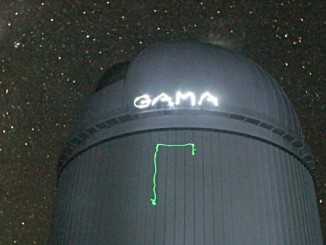
SKA


Hotspots in Cygnus A: an active galactic nucleus
Newly obtained radio images of the dramatic bipolar jets of charged particles being ejected from the nucleus of galaxy Cygnus A were able to resolve hotspots in the jets at the places where they impact the surrounding medium. A bright radio galaxy such as this can beam as much as one trillion solar luminosities of radiation into space at those wavelengths.

Australian technology runs world’s largest single-dish radio telescope in China
The world’s largest filled single-dish radio telescope launched at the weekend, and it relies on a piece of West Australian innovation. The 500-metre-wide telescope — known as FAST — uses a data system developed at the International Centre for Radio Astronomy in Perth and the European Southern Observatory to manage the huge amounts of data it generates.

What happened after the lights came on in the universe?
The National Science Foundation has approved funding to expand the Hydrogen Epoch of Reionisation Array (HERA) in South Africa. Upgrading the number of antennas from 19 to 240 by the year 2018 will enable HERA to study more clearly the impact of cosmic dawn, the moment a few hundred million years after the Big Bang when the first stars and galaxies blazed awake.

World’s biggest telescope meets second-fastest supercomputer
A prototype part of the software system to manage data from the Square Kilometre Array (SKA) telescope has run on the world’s second-fastest supercomputer in China. The SKA is arguably the world’s largest science project, with the low-frequency part of the telescope alone set to have more than a quarter of a million antennas facing the sky.

Mysterious alignment of black holes discovered
Deep radio imaging by researchers in the University of Cape Town and University of the Western Cape, in South Africa, has revealed that supermassive black holes in a region of the distant universe are all spinning out radio jets in the same direction — most likely a result of primordial mass fluctuations in the early universe.

Researchers find a new way to weigh pulsars
Until now, scientists have determined the mass of stars, planets and moons by studying their motion in relation to others nearby, using the gravitational pull between the two as the basis for their calculations. However, in the case of young pulsars, mathematicians at the University of Southampton have now found a new way to measure their mass — even if a star exists on its own in space.

Galaxy survey charts the fading and slow death of the universe
An international team of astronomers studying more than 200,000 galaxies has made the most comprehensive assessment of the energy output of the nearby universe. The Galaxy And Mass Assembly (GAMA) project confirms that the energy produced is only about half what it was two billion years ago and this fading is occurring across all wavelengths from the ultraviolet to the far infrared. The universe is slowly dying.


